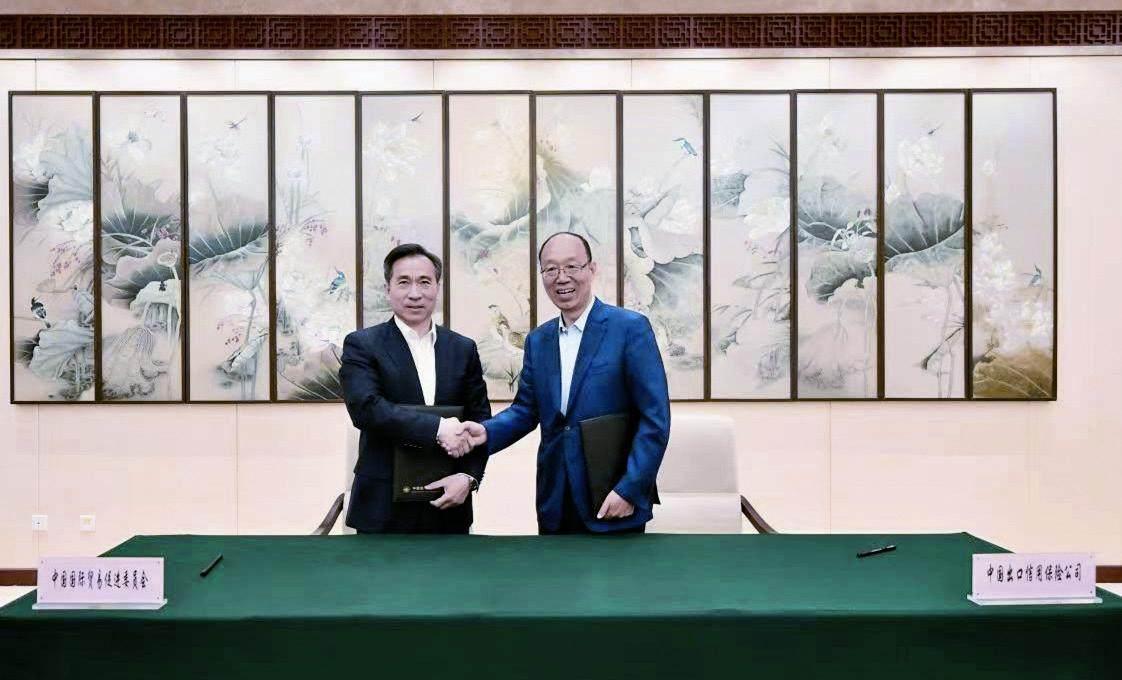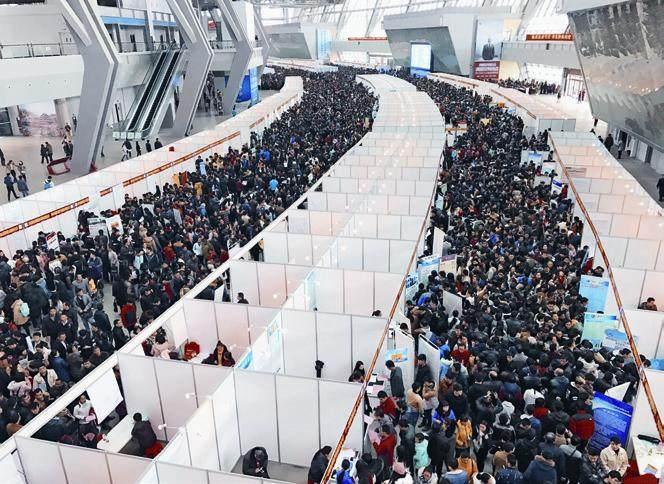CCPIT Signs MOU on Strategic Cooperation with SINOSURE
CCPIT
CCPIT Signs MOU on Strategic Cooperation with SINOSURE
On April 24, Ren Hongbin, Chairman of the China Council for the Promotion of International Trade (CCPIT), met in Beijing with Song Shuguang, Chairman of China Export & Credit Insurance Corporation(SINOSURE). The two sides signed the Memorandum of Understanding(MOU) on Strategic Cooperation.
Ren Hongbin said that the CCPIT and the SINOSURE have maintained close cooperation to provide support and services for foreign trade and enterprises that “go global”. Taking the MOU on Strategic Cooperation as a new starting point, the CCPIT would like to further promote the quality of bilateral cooperation, and make greater contribution to serving a higher level of openingup and accelerating the establishment of a new development paradigm.
Song Shuguang briefly introduced the work of SINOSURE and expressed that SINOSURE is ready to establish closer cooperation with the CCPIT to better leverage the policy-backed export credit insurance and promote high-quality development of foreign trade and investment.
According to the MOU on Strategic Cooperation, the cooperation between the two sides will focus on improving the quality and efficiency of foreign trade, advancing the Belt and Road Initiative, promoting coordination and sharing of policy information, deepening practical cooperation on commercial laws, and participating in major diplomatic events and foreign affairs.
Zhang Shenfeng, Vice Chairman of the CCPIT, and Zhang Hui, Vice President of SINOSURE, attended the signing ceremony. Heads of relevant departments of the two sides were also present.
The District 2020: Dubai Expos Sustainable Legacy Was Held
On April 13, Zhang Shenfeng, Vice Chairman of the China Council for the Promotion of International Trade (CCPIT) and Comminssioner General of China Pavilion at Expo 2020 Dubai, attended and addressed the District 2020: Dubai Expos Sustainable Legacy, an event on how to make the most out of the expo site. Ali Obaid Al Dhaheri, Ambassador of the United Arab Emirates to the Peoples Republic of China, Sanjive Khosla, Senior Vice President of Transition Unit of Expo 2020 Dubai site, and Issam Kazim, CEO of Dubai Corporation for Tourism and Commerce Marketing (DCTCM), attended the event.
Zhang Shenfeng said that China thanks all relevant parties of the UAE for their strong support to the China Pavilion at the Expo 2020 Dubai. China stands ready to exchange experience with UAE in the development and utilization of the Expo site after it closed its doors, and is actively promoting the utilization of the China Pavilion, so as to contribute to the continued expansion of Chinas participation in the Expo and the promotion of economic and trade cooperation between China and the UAE enterprises.
The event, hosted by the Embassy of the UAE in Beijing, aims to promote the utilization of the Dubai Expo site and the deepening opportunities of ChinaUAE cooperation. Representatives of relevant media, enterprises and tourism agencies from China and the UAE attended the event.
The First Virtual Meeting of RCEP Business Advisory Council Was Held
On April 22, the first meeting of the Regional Comprehensive Economic Partnership (RCEP) Business Advisory Council (the Council) was held via video link. Zhang Shaogang, Vice Chairman of the China Council for the Promotion of International Trade (CCPIT), attended and addressed the meeting as co-chair of the Council.
Zhang Shaogang said 100 days after the RCEP came into effect, initial results have been achieved in the promotion of foreign trade among member countries. The establishment of the Council is not only an important measure taken by the business communities of East Asia to promote practical cooperation, but also a significant vehicle for promoting regional growth, demonstrating the willingness of the business communities in the region to support multilateralism and free trade, and to deepen economic and trade cooperation. All member countries should give full play to the advantages of the Council as a platform to serve the practical cooperation of enterprises and promote economic growth within the region.
At the meeting, members of the Council were introduced, and the Articles of Association of the Council, as well as major work and activities for 2022, were reviewed and approved. More than 30 representatives from the members of the Council joined the meeting online.
FIGURES
RMB 469 billion
The total output value of Chinas satellite navigation and location services industry reached RMB 469 billion (about USD 69.6 billion) in 2021, up 16.3% from the previous year.
23.6%
In the January-April period, the capacity of wind power jumped 17.7% year-on-year to around 340 million kilowatts, while solar farms saw capacity hit 320 million kilowatts, an increase of 23.6%, according to the National Energy Administration.
USD 46.12 billion
China exported USD 46.12 billion worth of toys in 2021, according to a white paper released by the China Toy & Juvenile Products Association.
3%
The number of ChinaEurope freight train trips rose 3% month-on-month to 1,170, spokesperson for the National Development and Reform Commission said.
10.3%
Chinas electricity consumption went up 10.3% year-on-year in 2021, as the countrys economy ended the year with a strong rebound despite sporadic epidemic resurgences.
26.3%
The countrys shipbuilders saw holding orders soar 26.3% on a yearly basis to 99.1 million dead weight tons in the first quarter of this year, accounting for 47.3% of the worlds total, data from Beijing-based China Association of the National Shipbuilding Industry (CANSI) showed.
1.3%
Total power use dropped by 1.3%, year-on-year, in April to 636.2 billion kilowatthours (kWh), said the National Energy Administration.
3.25 billion
In 2021, Chinas domestic travel sector rose 13% year-on-year to around 3.25 billion visits to tourist attractions, according to the Ministry of Culture and Tourism.
2.3 billion
In April, the 38 Chinese game developers garnered over USD 2.3 billion worldwide, taking up 41.8% of the total revenue generated by the top 100 firms on the Apple App Store and Google Play, data from Sensor Tower showed.
46.5%
Chinas warehouse storage market shrank in April due to COVID-19 disruptions, the index tracking the sectors development dropped 0.4% from March to 46.5%, a survey jointly released by the China Federation of Logistics and Purchasing and CMST Development Co Ltd. showed.
10.3%
For the first quarter of 2022, the countrys raw coal output rose 10.3% yearon-year to 1.08 billion tons, while crude oil output saw steady expansion of 4.4% and power generation rose 3.1% from a year ago to reach 1.99 trillion kilowatt-hours.
25.8%
Chinas services trade value grew 25.8% year-on-year in the first quarter of 2022, data from the Ministry of Commerce showed.
QUOTES
Power generation, freight volume and bank loans have all declined since April. Without a certain level of GDP growth, stable employment cannot be realized. One good thing is that we refrained from excessive money supply and mass stimulus in the past few years, and we still have policy tools in reserve.
— Premier Li Keqiang
Access to this massive market (China) is essential for the success of any globally competitive chip firm today and in the future.
— The Semiconductor Industry Association, a Washington-based group that represents the US semiconductor industry, in a research report
Over the past year and more, authorities have conducted intensive and special rectifications of improper behaviors on the platform economy and have achieved the desired effect of a fairer market environment. Now, it is time for China to come back to normalized and predictable supervision in the sector.
— Wang Xianlin, a member of the expert advisory group of the State Councils Anti-Monopoly Commission
In the past few years, Chinas contribution to global GDP growth has been over 25%. Thats bigger than the combined contribution from India and the US.
— Zhu Ning, Deputy Dean of Shanghai Jiao Tong Universitys Shanghai Advanced Institute of Finance
Globalization has worked well. What we are only talking about here is some regionalization of the supply chain, essentially out of newly identified constraints, which is a lack of reliability of global transport.
— Tassel, P&G Europe President
We should step up efforts to broaden employment channels and provide a high-quality workforce to drive the countrys highquality economic development.
— Yao Kai, director of a research center under the Fudan University
POLICIES
Stronger Efforts Urged to Boost Growth, Jobs
Premier Li Keqiang called on May 25 for heightened efforts to ensure economic growth in the second quarter and bring down the unemployment rate, saying that the governments aid packages must be extended to all eligible businesses.
Speaking at a national teleconference on stabilizing the fundamentals of the economy, Li said that Chinas economy, in some respects, now faces difficulties even greater than in early 2020, when the nation was hit hard by COVID-19.
He pointed to sluggish indicators in the job market, industrial production, power consumption and freight volume, saying that growth remains a key factor underpinning all solutions to problems faced by the nation.
Li highlighted the significance of the current period in deciding the momentum of economic growth this year, saying that it is important to seize the window of opportunity to bring the economy back on track.
The premier reiterated the need to protect market players in protecting payrolls and public wellbeing, a move that is also key to protecting the resilience of the Chinese economy.
The meeting was held after Chinas economic activity, hit hard by a surge in cases of the Omicron variant of the coronavirus and by lockdown in some economic powerhouses of the nation, contracted in April and was the most severe since early 2020 during the first wave of the COVID-19 outbreak.
China to Strengthen Multiple Supports for Small, Medium Enterprises
China will ramp up multiple policy supports, including cutting costs and increasing funding, to help small and medium-sized companies tide over difficulties, officials told a press conference recently.
Chinas small and medium-sized firms logged stable growth in the first quarter of 2022, with the combined revenue and profit of major industrial companies up 14.1% and 6.5% year-on-year, respectively, Vice-Minister of Industry and Information Technology Xu Xiaolan said.
To address difficulties faced by smaller firms in costs, financing and logistics, local authorities have introduced policies to offer subsidies for spending on rent, utilities, loan repayments and social security premiums, Xu said.
The country has also taken multiple measures to increase inclusive loans and clear arrears for smaller firms, while promoting work resumption at key smaller firms on the industrial chain and boosting market demand.
The ministry will further promote the implementation of the supporting policies, prevent and clear arrears owed to smaller businesses, facilitate the symbiosis of small, medium and large companies, and build a system to nurture high-quality smaller firms, Xu said.
In terms of financing support, China will guide large State-owned banks to offer RMB 1.6 trillion of inclusive loans to micro and small firms this year, said Mao Hongjun from the China Banking and Insurance Regulatory Commission.
The commission will also encourage banking and insurance institutions to increase credit loans and ease the difficulties of loan repayments for smaller firms, and help them better cope with risks by offering tailored services and insurance products.
NDRC to Step up Push for Building National Unified Market
Chinas accelerated push for building a national unified market will create broader development space for all players, including foreign businesses, signaling a key step to deepen market-oriented reforms and foster high-quality development, officials and experts said.
The National Development and Reform Commission, Chinas top economic regulator, said in a statement that China aims to build a unified and fully open market, offering a better environment and larger development space for domestic and foreign businesses.
The remarks came after the Communist Party of China Central Committee and the State Council jointly released a guideline on April 10 on accelerating the establishment of a national unified market, aimed at ending local protectionism and unifying the fragmented market to remove key hurdles to economic growth.
The NDRC said establishing a unified and wellregulated market will give full play to its decisive role in allocating resources and help transform the governments functions.
According to the NDRC, building a national unified market will provide strong support for China to create a new economic development pattern of “dual-circulation”that takes the domestic market as the mainstay while domestic and foreign markets complement each other.
To build such an open national market, the State Administration for Market Regulation said that it will mainly focus on fields related to market access, fair competition, supervision on credit and intellectual property protection to accelerate the establishment of rules in a unified market system.
- China’s foreign Trade的其它文章
- The Beijing Initiative of the Global Trade and Investment Promotion Summit Was Released
- The 70th Anniversary of the CCPIT:Share Development Opportunities and Achieve Mutual Benefits
- The 2022 Boao Forum for Asia for Global Development and A Shared Future
- China and New Zealand Move to“RCEP+”Cooperation
- China Is Still Regarded As One of the Major Strategic Markets
- China-Thailand Trade Enjoys Multiple Dividends With the Effect of the RCEP

